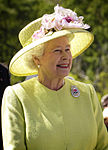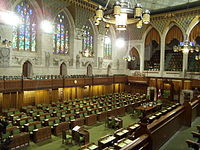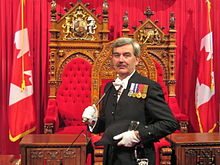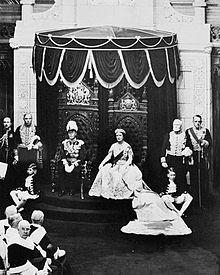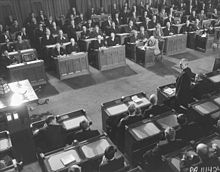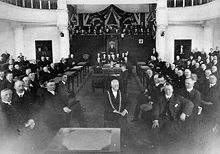
Parliament of Canada
Background Information
The articles in this Schools selection have been arranged by curriculum topic thanks to SOS Children volunteers. Click here for more information on SOS Children.
| Parliament of Canada Parlement du Canada |
|
|---|---|
| 41st Canadian Parliament | |
 |
|
| Type | |
| Type | Bicameral |
| Houses | Senate House of Commons |
| Leadership | |
| Monarch | Elizabeth II Since 6 February 1952 |
| Governor General | David Lloyd Johnston Since 1 October 2010 |
| Speaker of the Senate | Noël Kinsella, Conservative Since 8 February 2006 |
| Speaker of the House of Commons | Andrew Scheer, Conservative Since 2 June 2011 |
| Structure | |
| Seats | 413 308 MPs 105 Senators |
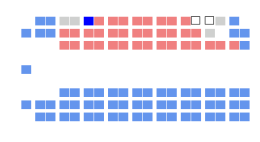 |
|
| Senate Political groups |
Conservative (64)
Liberal (36)
Progressive Conservative (1)
Independent (3)
Vacant (1)
|
 |
|
| House of Commons Political groups |
Conservative (165)
New Democratic (100)
Liberal (35)
Bloc Québécois (5)
Green (1)
Independent Conservative (1)
Independent (1)
Vacant (0)
|
| Elections | |
| Senate Voting system | Appointment by the governor general on advice of the prime minister |
| House of Commons Voting system | Plurality by constituency |
| House of Commons Last election | 2 May 2011 |
| Meeting place | |
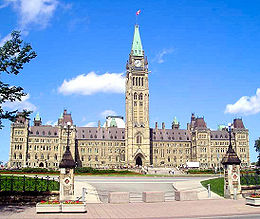 |
|
| Centre Block Parliament Hill Ottawa, Ontario Canada |
|
| Website | |
| Parliament of Canada | |
The Parliament of Canada (French: Parlement du Canada) is the federal legislative branch of Canada, seated at Parliament Hill in the national capital, Ottawa. Formally, the body consists of the Canadian monarch—represented by a viceroy, the governor general—the Senate, and the House of Commons, each element having its own officers and organization. The governor general summons and appoints each of the 105 members of the upper house on the advice of the Prime Minister of Canada, while the 308 members of the lower house are directly elected by eligible voters in the Canadian populace, with each Member of Parliament representing a single electoral district, commonly referred to as a riding.
By constitutional convention, the House of Commons is the dominant branch of parliament, the Senate and Crown rarely opposing its will. The Senate thus reviews legislation from a less partisan standpoint, and the monarch and viceroy provide the necessary Royal Assent to make bills into law and summon, prorogue, and dissolve parliament in order to call an election, as well as reading the Throne Speech. The current parliament, summoned by Governor General David Johnston on 2 June 2011, is the 41st since Confederation.
Composition
The Parliament of Canada is composed of three parts: the monarch, the Senate, and the House of Commons. Each has a distinct role, but work in conjunction within the legislative process. This format was inherited from the United Kingdom, and thus is a near identical copy of the parliament at Westminster, the greatest differences stemming from situations unique to Canada, such as the impermanent nature of the monarch's residency in the country and the lack of a peerage to form the upper chamber.
Only those who sit in the House of Commons are called members of parliament (MPs); the term is never applied to senators, even though the Senate is a part of parliament. Though legislatively less powerful, senators take higher positions in the national order of precedence. No individual may serve in more than one chamber of parliament at the same time.
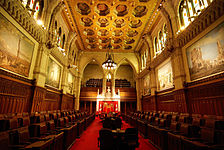
The Senate
|
Queen-in-Parliament
The sovereign's place in the legislature, formally called the Queen-in-Parliament, is defined by the Constitution Act, 1867 and various conventions. Neither she nor her viceroy, however, participates in the legislative process, save for signifying the Queen's approval to a bill passed by both houses of parliament, known as the granting of Royal Assent, which is necessary for a bill to be enacted as law. All federal bills thus begin with the phrase "Now, therefore, Her Majesty, by and with the advice and consent of the Senate and House of Commons of Canada, enacts as follows..." and, as such, the Crown is immune from acts of parliament unless expressed otherwise in the act itself. The governor general will normally perform the task of granting Royal Assent, though the monarch may also do so, at the request of either the Cabinet or the viceroy, who may defer assent to the sovereign as per the constitution.
As both the monarch and his or her representatives are traditionally barred from the House of Commons, any parliamentary ceremonies in which they are involved take place in the Senate chamber. The lower and upper houses do, however, each contain a mace, which indicate the authority of the Queen-in-Parliament, and the privilege granted to that body by her, both bearing a crown at their apex. The original mace for the Senate was that used in the Legislative Council of the Province of Canada after 1849, while that of the House of Commons was inherited from the Legislative Assembly of Upper Canada, first used in 1845. Following the burning of the Centre Block on 3 February 1916, the City of London, England, donated a replacement, which is still used today. The temporary mace, made of wood, and used until the new one arrived from the United Kingdom in 1917, is still carried into the Senate each 3 February.
Members of the two houses of parliament must also express their loyalty to the sovereign and defer to her authority, as the Oath of Allegiance must be recited by all new parliamentarians before they may take their seats, and the official opposition is formally called as Her Majesty's Loyal Opposition, to demonstrate that though they may be opposed to the incumbent Cabinet's policies, these MPs remain dedicated to the apolitical Crown.
Senate
The upper house of the Parliament of Canada, the Senate, is a group of 105 individuals appointed by the governor general on the advice of the prime minister; all those summoned to the Senate by the viceroy must, per the constitution, be a minimum of 30 years old, be a subject of the monarch, and own property with a net worth of at least $4,000, in addition to owning land worth no less than $4,000 within the province he or she is to represent. Senators served for life until 1965, when a constitutional amendment imposed a mandatory retirement age of 75. Senators may, however, resign their seats prior to that mark, and can lose their position should they fail to attend two consecutive sessions of parliament.
The Senate is divided equally amongst four geographic regions: 24 for Ontario, 24 for Quebec, 24 for the Maritimes (10 for Nova Scotia, 10 for New Brunswick, and four for Prince Edward Island), and 24 for the Western provinces (six each for Manitoba, British Columbia, Saskatchewan, and Alberta). Newfoundland and Labrador, which became a Canadian province in 1949, is represented by six senators, though the province is not part of a senatorial division. Further, Canada's three territories—the Northwest Territories, the Yukon, and Nunavut—are allocated one senator each. An additional four or eight senators may be temporarily appointed by the governor general, provided the approval of the Queen is secured, and the four divisions are equally represented, thus putting the maximum possible number of senators at 113. This power has been employed only once since 1867: to ensure the passage of the bill establishing the Goods and Services Tax, Prime Minister Brian Mulroney in 1990 advised Queen Elizabeth II to appoint extra senators.
The House of Commons
The elected component of the Canadian parliament is the House of Commons, with each member chosen by a majority of eligible voters in each of the country's federal electoral districts, or ridings, via a plurality voting system. To run for one of the 308 seats in the House of Commons, an individual must be at least 18 years old, and each winner holds office until parliament is dissolved, after which they may seek re-election indefinitely. The ridings are regularly reorganised according to the results of each decennial national census; however, the "senatorial clause" of the Constitution Act, 1867, guarantees each province at least as many MPs as it has senators, and the "grandfather clause" permits each province as many MPs as it had in either 1976 or 1985. The existence of this legislation has pushed the size of the House of Commons above the required minimum of 282 seats.
Jurisdiction
The powers of the Parliament of Canada are limited by the constitution, which divides legislative abilities between the federal and provincial governments; in general, provincial legislatures may only pass laws relating to topics explicitly reserved for them by the constitution, such as education, provincial officers, municipal government, charitable institutions, and "matters of a merely local or private nature," while any matter not under the exclusive authority of the provincial Legislatures is within the scope of the federal parliament's power. Thus, parliament alone can pass laws relating to, amongst other things, the postal service, the census, the military, navigation and shipping, fishing, currency, banking, weights and measures, bankruptcy, copyrights, patents, First Nations, and naturalization. In some cases, however, the jurisdictions of the federal and provincial parliaments may be more vague. For instance, the parliament in Ottawa regulates marriage and divorce in general, but the solemnization of marriage is regulated only by the provincial legislatures. Other examples include the powers of both the federal and provincial parliaments to impose taxes, borrow money, punish crimes, and regulate agriculture.
The powers of the Canadian parliament are also limited by the Canadian Charter of Rights and Freedoms, though most provisions in that document can be overridden by an act that includes a notwithstanding clause. Such a claim, however, has never been used by the federal parliament, though it has been employed by some provincial legislatures. Laws violating any part of the constitution are invalid and may be ruled unconstitutional by the courts.
Officers
Each of the parliament's two chambers is presided over by a speaker; that for the Senate is a member of that house appointed by the governor general, as advised by the prime minister, while the equivalent for the House of Commons is a member of parliament elected by the other members of that body. In general, the powers of the latter are greater than those of the former; following the British model, the upper chamber is essentially self-regulating, whereas the lower chamber is controlled from the chair. In 1991, however, the powers of the Speaker of the Senate were expanded, moving the position closer to that in the Commons.
The Usher of the Black Rod of the Senate of Canada is the most senior protocol position in parliament, being the personal messenger to the legislature of the sovereign and/or governor general. He or she is also a floor officer of the Senate responsible for security in that chamber, as well as for protocol, administrative, and logistical details of important events taking place on Parliament Hill, such as the Speech from the Throne, Royal Assent ceremonies, state funerals, or the investiture of a new governor general.
Other officers of parliament include the Auditor General, Chief Electoral Officer, Official Languages Commissioner, Privacy Commissioner, Access to Information Commissioner, Conflict of Interest and Ethics Commissioner, Public Sector Integrity Commissioner, and Commissioner of Lobbying. These individuals are appointed by either one or both houses, to which they report through the speaker of that house. They are sometimes referred to as Agents of Parliament.
Another key official is the Parliamentary Librarian of Canada, a position established in 1871 under the Library of Parliament Act, and is charged with the running of the Library of Parliament.
Term
The Constitution Act, 1867, outlines that the governor general alone is responsible for summoning parliament, though it remains the monarch's prerogative to prorogue and dissolve the legislature, after which the writs for a general federal election are usually dropped by the governor general at Rideau Hall. Upon completion of the election, the viceroy, on the advice of his or her prime minister, then issues a royal proclamation summoning Parliament to assemble. On the date given, new MPs are sworn-in and then are, along with returning MPs, called to the Senate, where they are instructed to elect their speaker, and return to the House of Commons to do so before adjourning.
The new parliamentary session is marked by the State Opening of Parliament, during which either the monarch, the governor general, or a royal delegate, reads the Speech from the Throne. MPs receive the Royal Summons to these events from the Usher of the Black Rod, after he knocks on the doors of the lower house that have been slammed shut, to illustrate the Commons' right to deny entry to anyone, including the monarch but excepting royal messengers. Once MPs are gathered behind the Bar of the Senate—save for the prime minister, the only MP permitted into the Senate proper to sit near the throne dais—the speaker of the lower house presents him or herself to the monarch or governor general, and formally claims the rights and privileges of the House of Commons, to which the Speaker of the Senate, on behalf of the Crown, replies in acknowledgement after the sovereign or viceroy takes their seat on the throne. The speech is then read, outlining the programme of the Cabinet for the upcoming legislative session.
A parliamentary session lasts until a prorogation, after which, without ceremony, both chambers of the legislature cease all legislative business until the governor general issues another proclamation calling for a new session to begin; except for the election of a speaker for the House of Commons and his or her claiming of that house's privileges, the same procedures for the opening of parliament are again followed. After a number of such sessions, each parliament comes to an end via dissolution, which is effected by the governor general. As a general election typically follows, the timing of a dissolution is usually politically motivated, with the prime minister selecting a moment most advantageous to his or her political party. The end of a parliament may also be necessary, however, if the majority of MPs revoke their confidence in the prime minister's ability to govern, or the legally mandated five-year maximum is reached; no parliament has been allowed to expire in such a fashion.
Procedure
Both houses determine motions by voice vote; the presiding officer puts the question and, after listening to shouts of "yea" and "nay" from the members, announces which side is victorious. This decision by the Speaker is final, unless a recorded vote is demanded by members—at least two in the Senate and five in the House of Commons. Members of both houses vote by rising in their places to be counted; the Speaker of the Senate is permitted to vote on a motion or bill—though does so irregularly, in the interest of impartiality—and, if there is no majority, the motion is defeated. In the Commons, however, the Speaker cannot vote, unless to break a tie, at which time he or she will customarily vote in favour of the status quo. The constitution establishes the quorums to be 15 senators in the upper house and 20 members in the lower house, the Speaker of each body being counted within the tally.
Voting can thus take three possible forms: whenever possible, leaving the matter open for future consideration and allowing for further discussion by the house; when no further discussion is possible, taking into account that the matter could somehow be brought back in future and be decided by a majority in the house; or, leaving a bill in its existing form rather than having it amended. For example, during the vote on the 2005 budget, which was considered a vote of confidence, the Speaker of the House of Commons cast the tie-breaking vote during the second reading, moving in favour of the budget and allowing its passage. If the vote on the third reading had again been tied, the speaker would have been expected to vote against the bill, bringing down the government.
Simultaneous interpretation for both official languages, English and French, is provided at all times during sessions of both houses.
Legislative functions
Laws, known in their draft form as bills, may be introduced by any member of either house. However, most bills originate in the House of Commons, of which most are put forward by ministers of the Crown, making them government bills, as opposed to private members' bills or private senators' bills, which are launched by MPs and senators, respectively, who are not in cabinet. Draft legislation may also be categorised as public bills, if they apply to the general public, or private bills, if they concern a particular person or limited group of people. Each bill then goes through a series of stages in each chamber, beginning with the first reading. It is not, however, until the bill's second reading that the general principles of the proposed law are debated; though rejection is a possibility, such is not common for government bills.
Next, the bill is sent by the house where it is being debated to one of several different committees. The Standing Orders outline the general mandate for all committees, allowing them to review: bills as they pertain to relevant departments; the program and policy plans, as well as the projected expenditures, and the effectiveness of the implementation thereof, for the same departments; and the analysis of the performance of those departments. Most often, bills end up before a standing committee, which is a body of members or senators who specialise in a particular subject (such as foreign affairs), and who may hear testimony from ministers and experts, debate the bill, and recommend amendments. The bill may also be committed to the Committee of the Whole, a body consists of, as the name suggests, all the members of the chamber in question. Finally, the bill could be referred to an ad hoc committee established solely to review the piece of legislation in question. Each chamber has their own procedure for dealing with this, with the Senate establishing special committees that function like most other committees, and the House of Commons establishing legislative committees, the chair of the latter being appointed by the speaker of the House of Commons, and is normally one of his deputies. Whichever committee is used, any amendments proposed by the committee are considered by the whole house in the report stage. Furthermore, additional amendments not proposed by the committee may also be made.
After the report stage (or, if the committee made no amendments to the bill, immediately after the committee stage), the final phase of the bill—the third reading—occurs, at which time further amendments are not permitted in the House of Commons, but are allowed in the Senate. If one house passes amendments that the other will not agree to, and the two houses cannot resolve their disagreements, the bill fails. If, however, it passes the third reading, the bill is sent to the other house of parliament, where it passes through the same stages; amendments made by the second chamber require the assent of the original house in order to stand part of the final bill. Once the bill is passed in identical form by both houses, it is presented for Royal Assent; in theory, the governor general has three options: he or she may grant Royal Assent, thereby making the bill into law; withhold Royal Assent, thereby vetoing the bill; or reserve the bill for the signification of the Queen's pleasure, which allows the sovereign to personally grant or withhold assent. If the governor general does grant Royal Assent, the monarch may, within two years, disallow the bill, thus annulling the law in question. In the federal sphere, no bill has ever been denied royal approval.
In conformity with the British model, only the House of Commons may originate bills for the imposition of taxes or for the appropriation of Crown funds. Otherwise, the theoretical power of both houses over bills is equal, with the assent of each being required for passage. In practice, however, the House of Commons is the dominant chamber of parliament, with the Senate rarely exercising its powers in a way that opposes the will of the democratically elected house.
Relationship with the executive
The Canadian government consists of the monarch, predominantly represented by his or her governor general, in Council, which is a collection of ministers of the Crown appointed by the governor general to direct the use of the executive powers. Per the tenets of responsible government, these individuals are almost always drawn from the parliament, and then are predominantly from the House of Commons, the only body to which the ministers are held accountable, typically during Question Period, wherein the ministers are obliged to answer questions posed by members of the loyal opposition. Hence, the person who can command the confidence of the lower chamber—usually the leader of the party with the most seats therein—is the one who is typically appointed as prime minister. Should that person not actually hold a seat in the House of Commons, he or she will, by convention, seek election to one at the earliest possible opportunity; frequently, in such situations, a junior Member of Parliament who holds a safe seat will resign to allow the prime minister to run for that riding in a by-election. If no party holds a majority, it is customary for the governor general to summon a minority government or coalition government, depending on which the Commons will support.
The lower house may attempt to bring down the government by either rejecting a motion of confidence—generally initiated by a minister to reinforce the Cabinet's support in the Commons—or by passing a motion of no confidence—introduced by the opposition to display its distrust of the Cabinet. Important bills that form part of the government's agenda will usually be considered matters of confidence, as are budgets. Where a government has lost the confidence of the House of Commons, the prime minister is obliged to either resign (allowing the governor general to appoint the Leader of the Opposition to the office), or seek the dissolution of parliament and call a new general election. A precedent, however, was set in 1968, when the government of Lester B. Pearson unexpectedly lost a confidence vote but was allowed to remain in power with the mutual consent of the leaders of the other parties.
In practice, the House of Commons' scrutiny of the government is very weak. With the plurality voting system used in parliamentary elections tending to provide the governing party with a large majority, and a party system that gives leaders strict control over their caucus (to the point that MPs may be expelled from their parties for voting against the instructions of party leaders), there is often limited need to compromise with other parties. Thus, defeats of majority governments on issues of confidence are very rare. In contrast, a minority government is more volatile, and is more likely to fall due to loss of confidence. The last prime minister to lose a confidence vote was Stephen Harper in 2011, prior to which was Paul Martin in 2005 and Joe Clark in 1979. All these occurrences involved minority governments.
Privileges
The institution of parliament possesses a number of privileges, collectively and accordingly known as parliamentary privilege, each house being the guardian and administrator of its own set of rights. Parliament itself determines the extent of parliamentary privilege, each house overseeing its own affairs, but the constitution bars it from conferring any "exceeding those at the passing of such an Act held, enjoyed, and exercised by the [British House of] Commons... and by the Members thereof."
The foremost dispensation held by both houses of the legislature is that of freedom of speech in debate; nothing said within the chambers may be questioned by any court or other institution outside of Parliament. In particular, a member of either house cannot be sued for slander based on words uttered in the course of parliamentary proceedings, the only restraint on debate being set by the standing orders of each house. Further, MPs and senators are immune to arrest in civil cases (but not for allegedly criminal actions), and from jury service and attendance in courts as witnesses. They may, however, be disciplined by their own colleagues for breach of the rules, including contempt of parliament—disobedience of its authority; for example, giving false testimony before a parliamentary committee—and breaches of its own privileges.
The Canadian Heraldic Authority, on 15 April 2008, granted the Parliament of Canada, as an institution, a heraldic achievement composed of symbols of the three elements of parliament: the escutcheon of the Royal Arms of Canada (representing the Queen) with the maces of the House of Commons and Senate crossed behind (representing each of those chambers).
The budget for the Parliament of Canada for the 2010 fiscal year was $583,567,000.
History
Following the surrender of New France to the United Kingdom in the 1763 Treaty of Paris, Canada was governed according to the Royal Proclamation issued by King George III in that same year. To this law was added the Quebec Act, by which the power to make ordinances was granted to a Governor-in-Council, both bodies appointed by the British monarch in London. In 1791, the Province of Quebec was divided into Upper and Lower Canada, each with an elected legislative assembly, an appointed legislative council, and the relevant governor, mirroring the parliamentary structure at Westminster. During the War of 1812, American troops set fire to the buildings of the Legislative Assembly of Upper Canada in York, now Toronto. In 1841 the British government united the two Canadas into the Province of Canada, with a single legislature composed of, again, an assembly, council, and governor general; the 84 members of the lower chamber were equally divided amongst the two former provinces, though Lower Canada had a higher population. The governor still held significant personal influence over Canadian affairs until 1848, when responsible government was implemented in Canada. The actual site of the parliament shifted on a regular basis: From 1841 to 1844, it sat in Kingston, where the present Kingston General Hospital now stands; from 1844 until the 1849 fire that destroyed the building, the legislature was in Montreal; and, after a few years of alternating between Toronto and Quebec City. In 1866, the legislature was finally moved to Ottawa, Queen Victoria having chosen that city as Canada's capital in 1857.
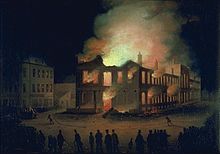
The modern-day parliament of Canada came into existence in 1867, in which year the legislatures of the Province of Canada, Nova Scotia, New Brunswick, and the United Kingdom all passed the British North America Act, 1867, uniting the aforementioned provinces—with the Province of Canada split into Quebec and Ontario—into a single federation, called the Dominion of Canada. Though the form of the new federal legislature was again nearly identical to the parliament of the United Kingdom, the decision to retain this model was made with heavy influence from the just-concluded American Civil War, which indicated to many Canadians the faults of the American federal system, with its relatively powerful states and a less powerful federal government. The British North America Act limited the powers of the provinces, providing that all subjects not explicitly delegated to them by that document remain within the authority of the federal parliament, while simultaneously giving the provinces unique powers in certain agreed-upon areas of funding.
Full legislative autonomy was granted by the Statute of Westminster, 1931, passed by the United Kingdom and ratified by the Canadian parliament. Though the statute allowed the Parliament of Canada to repeal or amend previously British laws as they applied to Canada, it did not permit the abrogation of Canada's constitution, including the British North America Acts. Hence, whenever a constitutional amendment was sought by the Canadian parliament, the enactment of a British law became necessary, though Canada's consent was required. The Parliament of Canada was granted limited power to amend the constitution by a British Act of Parliament in 1949, but it was not permitted to affect the powers of provincial governments, the official positions of the English and French languages, or the maximum five-year term of the legislature.
The Canadian Cabinet last requested the Parliament of the United Kingdom to enact a constitutional amendment in 1982, in the form of the Canada Act. This legislation terminated the power of the British parliament's ability to legislate for Canada, and the authority to amend the constitution was transferred to Canadian legislative authorities. Most amendments require the consent of the Senate, the House of Commons, and the legislative assemblies of two-thirds of the provinces representing a majority of the population; the unanimous consent of provincial legislative assemblies is required for certain amendments, including those affecting the sovereign, the governor general, the provincial lieutenant governors, the official status of the English and French languages, the Supreme Court of Canada, and the amending formulas themselves.

